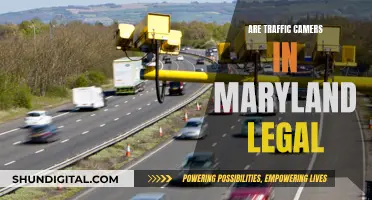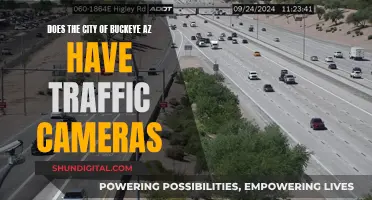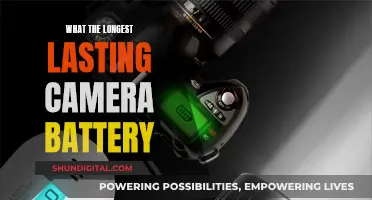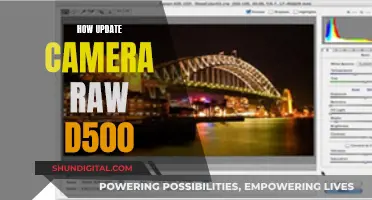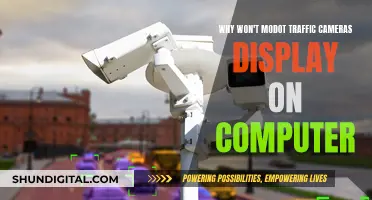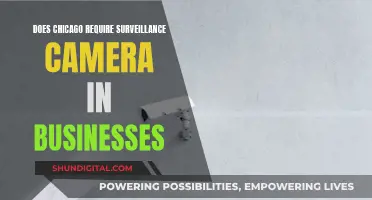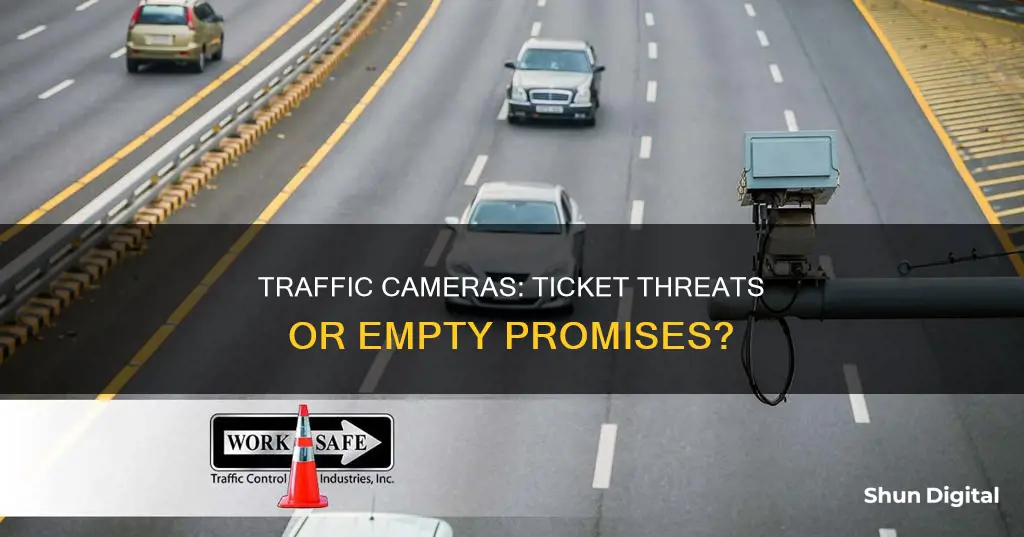
Traffic cameras are often confused with red-light cameras, but they do not issue tickets. They are usually placed on top of traffic lights and are used to monitor traffic flow. Red-light cameras, on the other hand, are placed at the side or corner of intersections and are ticket-issuing machines. They capture images or videos of vehicles that run red lights, and the driver or vehicle owner receives a ticket in the mail. While red-light cameras do not result in criminal charges, they can affect your credit and driving record if left unpaid, which may lead to increased insurance rates.
| Characteristics | Values |
|---|---|
| Purpose | Monitoring traffic flow, enforcing traffic rules |
| Ticket Issuing | Yes, but only for certain types of cameras |
| Ticket Type | Administrative violations, similar to parking tickets |
| Consequences of Unpaid Tickets | Unable to renew vehicle registration, negative impact on credit |
| Locations | Traffic poles, intersections, school zones, highways, etc. |
| Warning Signs | Required in areas with enforcement cameras |
What You'll Learn
- Red light cameras issue tickets to drivers entering intersections at red lights
- Speed cameras monitor drivers breaking the speed limit
- Traffic cameras are monitoring systems to measure travel times and study traffic
- School zone speed cameras enforce speed limits near schools
- High Occupancy Vehicle (HOV) lane cameras enforce lane infractions

Red light cameras issue tickets to drivers entering intersections at red lights
Traffic cameras do not issue tickets, but red light cameras do. Red light cameras are located on the side or corner of an intersection and are equipped with sensors that detect when a vehicle enters the intersection at a red light. They then take multiple pictures of the car and its license plate as evidence.
The owner of the vehicle will then receive a notice of liability in the mail, which includes the date and time of the violation, the street lane that triggered the camera, and photos of the incident. This is considered an administrative violation, similar to a parking ticket, and does not result in any points on the driver's record or insurance increases. However, failure to pay the ticket can lead to a negative impact on credit ratings and higher auto insurance rates.
Red light camera tickets are used to reduce the number of vehicles proceeding through intersections after the signal has turned red, promoting road safety and deterring dangerous driving behaviors. The penalty for these tickets typically includes a fine, and in some cases, additional penalties such as a hold on vehicle registration or late fees if the fine is not paid by the due date.
Privacy Mode: ADT Camera's Secret Superpower Explained
You may want to see also

Speed cameras monitor drivers breaking the speed limit
Traffic cameras are used to monitor general traffic conditions and are not the same as road safety cameras. Speed cameras are a type of road safety camera that specifically monitors drivers breaking the speed limit.
Speed cameras are an integral part of the UK road network and are used to enforce speed limits. They are usually placed on poles above roadways and can be fixed or mobile. Fixed-speed cameras are almost always placed high up on separate poles next to the road, while mobile speed cameras are more difficult to spot as they are not fixed to the ground and can be placed on a tripod or inside a van.
Speed cameras work by measuring the speed of passing vehicles and taking photographs of those that are speeding. Some speed cameras use radar technology, while others use sensors in the road to detect speeding vehicles. In the UK, if you are caught speeding by a speed camera, you may receive a verbal or written warning, points on your driving licence, an invitation to attend a speed awareness course, or a notice to go to court.
In addition to speed cameras, red-light cameras are also used to enforce traffic laws. These cameras are set up at busy intersections and can detect when a driver enters the intersection on a red light. They will then take multiple pictures of the car and the driver as evidence of the violation.
Mastering the Microsoft Surface Book's Selfie Mode Switch
You may want to see also

Traffic cameras are monitoring systems to measure travel times and study traffic
Traffic cameras are monitoring systems that are placed on major roads like highways, freeways, expressways, and arterial roads. They are often connected to each other by optical fibres buried next to or under the road. These cameras are typically powered by mains electricity, solar panels, or other power sources that are reliable and don't experience outages.
Traffic cameras are distinct from road safety cameras, which are installed in specific locations to enforce compliance with speed limits, traffic signals, and other road rules. Unlike safety cameras, traffic cameras capture lower-resolution videos continuously and are not tied to any law enforcement system. Instead, they are primarily used to measure travel times and study traffic flow.
While traffic cameras themselves don't issue tickets, technologies like Automated Number Plate Recognition (ANPR) can be used in conjunction with traffic cameras for tracking driver whereabouts and enforcing road rules. ANPR systems can identify untaxed, uninsured, or stolen vehicles, and have also raised concerns about government surveillance of vehicle movements.
In summary, traffic cameras play a crucial role in monitoring and studying traffic conditions, while also providing data that can be leveraged for various purposes, including traffic management and road safety enforcement.
Smart Strategies for Carrying Extra Camera Batteries
You may want to see also

School zone speed cameras enforce speed limits near schools
Traffic cameras are indeed used to enforce speed limits near schools in certain cities. In Seattle, for example, the city uses fixed cameras to enforce a 20 mph speed limit near elementary and middle schools. The cameras are only operational when the school zone flashing beacons are in operation, and the schedule for this is set by the Seattle Department of Transportation based on when students are arriving and leaving school grounds.
Similarly, in New York City, the use of speed cameras in school zones has been expanded to 24 hours a day, seven days a week. This expansion is part of a comprehensive plan to eliminate traffic deaths and serious injuries. The city operates speed cameras in 750 school speed zones, and if a vehicle is observed travelling more than 10 mph over the speed limit, a ticket will be issued to the owner of the vehicle.
Speed cameras are usually placed on poles above roadways and are typically fixed in position, although mobile speed cameras do exist and are more challenging to spot. While traffic cameras themselves do not issue tickets, they are used to monitor general traffic conditions.
Charging the Kodak EasyShare M22: A Step-by-Step Guide
You may want to see also

High Occupancy Vehicle (HOV) lane cameras enforce lane infractions
Traffic cameras are indeed used to enforce traffic rules and issue tickets to violators. These cameras are placed strategically on major roads, highways, freeways, and arterial roads, and they monitor various traffic conditions and driver behaviours. While traditional traffic cameras do not issue tickets, advanced automated traffic enforcement cameras (ATECs) are capable of issuing penalties and violations.
High Occupancy Vehicle (HOV) lane cameras are a type of ATEC that specifically targets vehicles violating HOV lane rules. HOV lanes are designed to improve traffic flow and reduce congestion by requiring a minimum number of passengers per vehicle, such as the three-passenger requirement in New York City. To enforce these rules, local governments like the NYPD are considering implementing camera-based HOV lane enforcement technology. This technology uses video analytics and geometric algorithms to accurately determine the number of occupants in a vehicle, without the need for facial recognition.
The system captures high-quality images and license plate data, which are then encrypted and stored locally. By automating the enforcement process, HOV lane cameras offer several benefits. Firstly, they improve safety by eliminating the need for police officers to park on the shoulder and manually check for violations, which can create dangerous situations when attempting to catch up with violators. Secondly, they help deter motorists from illegally using HOV lanes, thereby improving the overall traffic flow and reducing congestion.
The effectiveness of HOV lane cameras has been demonstrated in cities like San Francisco, which conducted a pilot program to test different camera systems. The successful implementation of these systems can lead to increased transit ridership and decreased travel times, even in general-purpose lanes. As a result, local governments and transportation departments are showing a keen interest in adopting this technology to enhance the performance of their transportation systems.
Best Action Cameras for Extended Recording Sessions
You may want to see also
Frequently asked questions
No, traffic cameras are there to monitor traffic flow and watch over general traffic conditions. They are not part of any law enforcement system.
Red-light cameras are ticket-issuing machines that are set up at busy intersections. They take photos or videos of your license plate and the driver's face.
If you don't pay your ticket, you won't be arrested, but your credit score will be affected, and your driving record could be blemished, which may lead to increased insurance rates.
Red-light cameras are usually placed near busy intersections, whereas speed cameras are often placed on poles above roadways.
You can file a Declaration of Non-Responsibility, which is a sworn statement that the vehicle was not in your care, custody, or control at the time of the violation.


